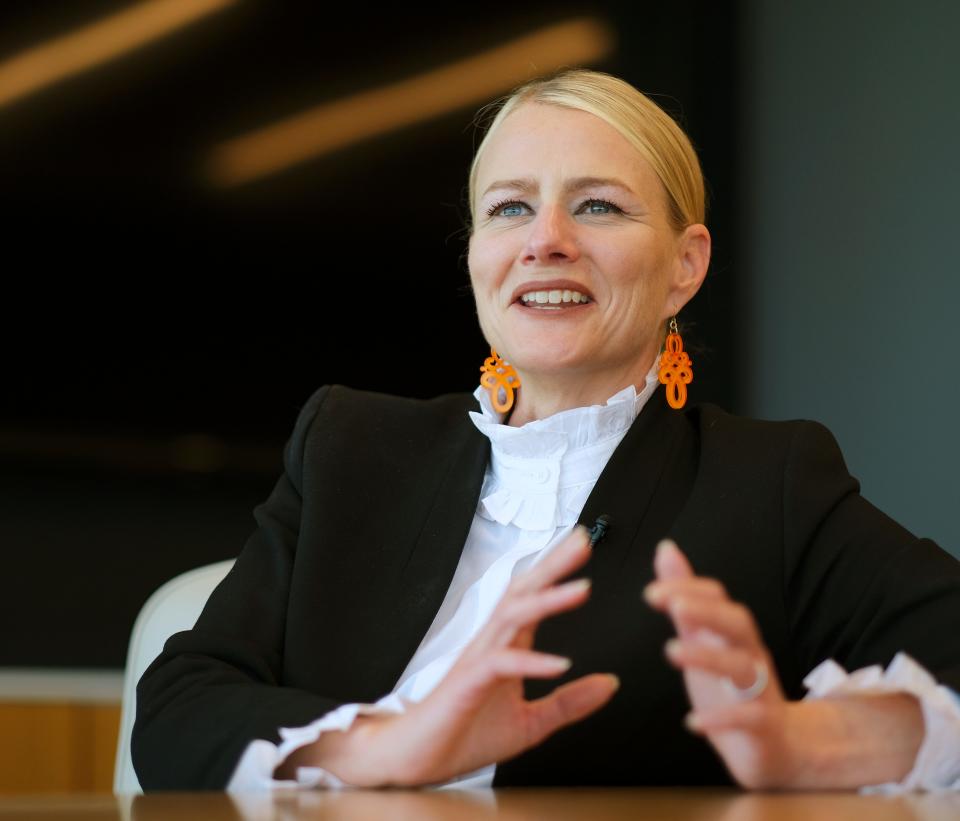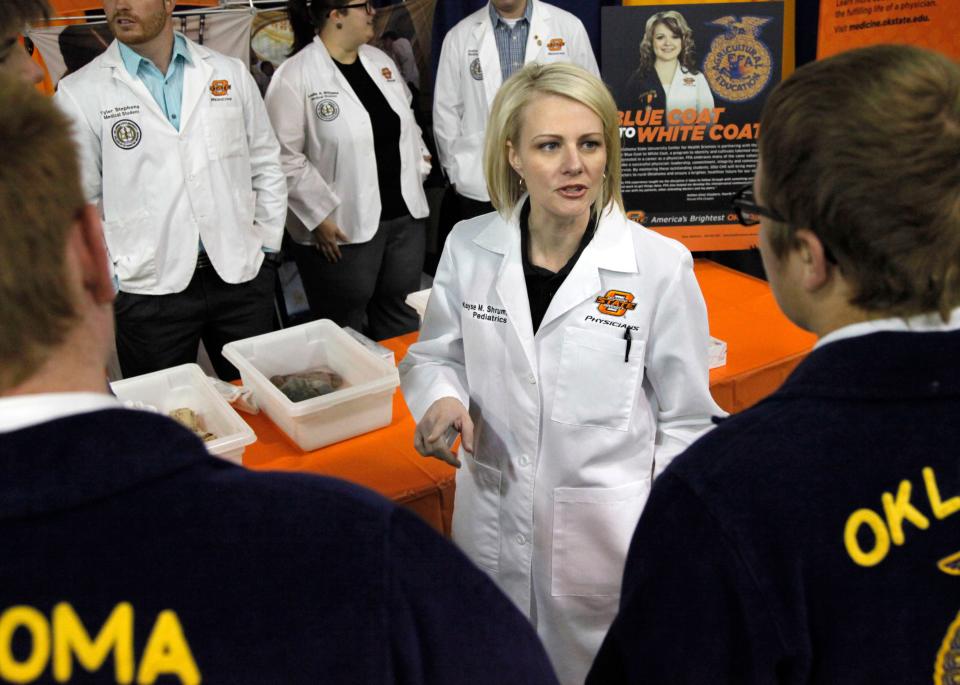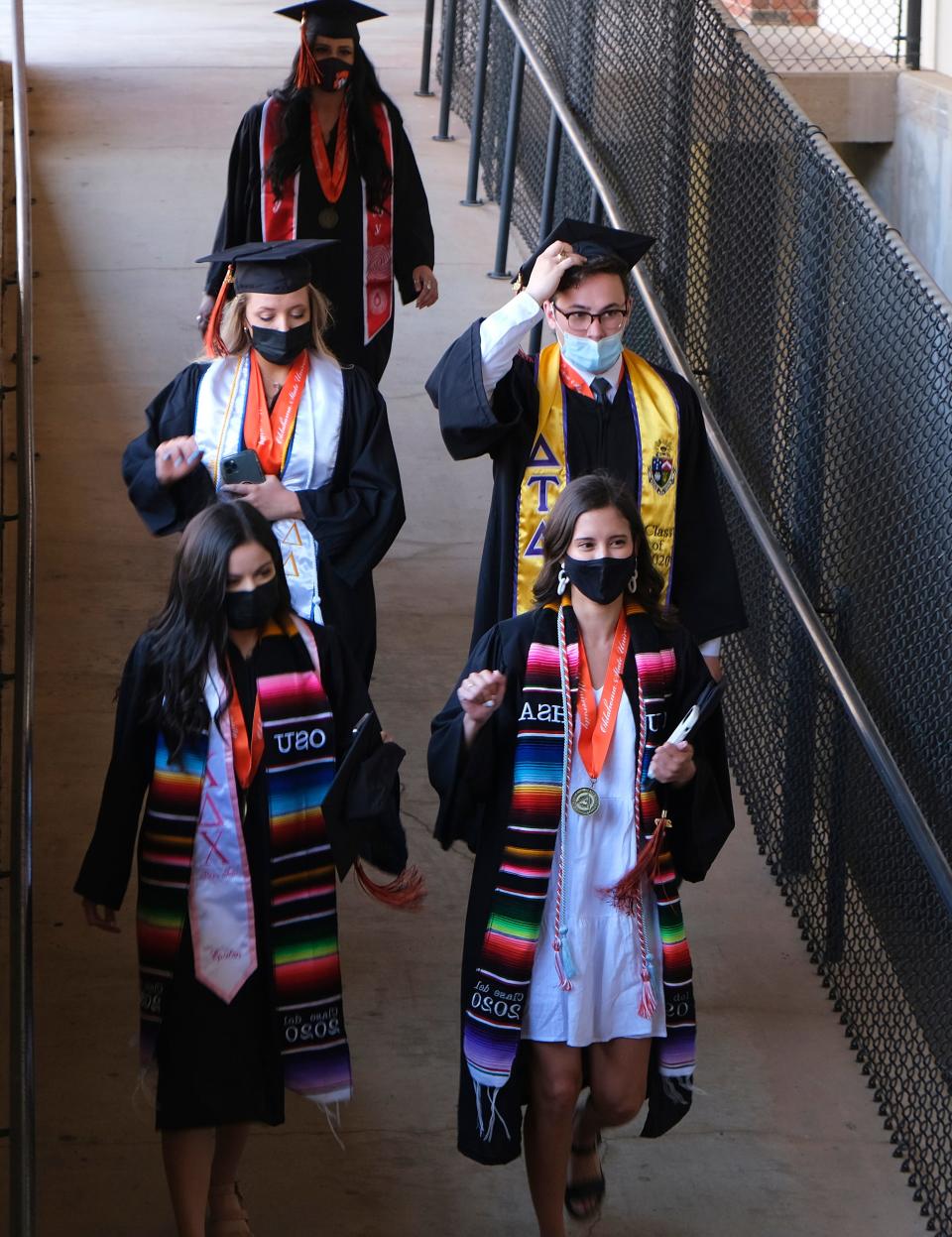OSU President Kayse Shrum 'very confident' in plan to graduate more students debt free
STILLWATER — Sitting in her office as campus homecoming festivities gathered steam, President Kayse Shrum pondered how many Oklahoma State University alumni would return someday without the yoke of college debt.
On Oct. 18, Shrum’s administration revealed a plan to graduate 60% of OSU students debt free, beginning with the freshman cohort arriving in fall 2026. Debt reduction is one of the chief tenets of the strategic vision, which pledged students who do accumulate debt would owe no more than $3,000 a year.
Right now, 40% of OSU students graduate debt free, the university reported. OSU students who finish college with loans have a median debt load of $20,500, according to the U.S. Department of Education.

On top of reducing loan burdens, the university aims to grow enrollment to 5,000 first-year students by 2026 — up from this year’s all-time high of 4,668 — and to improve its six-year graduation rate by 10% in 2027.
OSU would have to offer $23 million more in scholarships to meet its 60% debt-free goal, Shrum said. Resources, such as expanded academic advising, would drive up costs to $47 million in additional expenses per year, Shrum said.
But, it’s a goal Shrum said she’s “very confident” OSU can reach. Land grant universities like OSU were founded in the late 19th century to educate the working agrarian class, meaning affordability and access are part of the school’s roots.
Shrum, a pediatrician and former head of OSU's medical school, took office as OSU president last year.
She discussed OSU’s strategic plan to become “the nation’s preeminent land grant university” in the following sit-down interview with The Oklahoman. Responses are lightly edited for brevity and style.
Q: How did the 60% debt free figure come to be? How do you reach that figure?
Shrum: “I think there’s several things that as I was coming into the presidency knowing that there were a lot of issues related to higher education, and student debt load is one of them. That was something I feel like we need to address. We’re looking to the future to say, 'OK, we know there’s the enrollment cliff with the decrease in number of 18-year-olds just based on demographics that will be coming in.' Lots of conversations about, ‘Is a degree worth it in the long run, and what’s the relevance?’ Those are all things in the back of my mind that I felt like we needed to address in our strategy because those are real issues, and if we don’t address those then we really are not listening to what people are questioning and needing.
“To the whole relevance piece, it’s not a message of telling people we’re relevant. It’s about being relevant (and) meeting society’s needs, and that’s what we were created to do as a land grant university. Access is a big piece of a land grant. If we are keeping people from being able to come to Oklahoma State University … because of price, then that’s something for us as a modern land grant to really think about is how do we address that issue, and what do we think is realistic.
“Obviously, that’s a pretty big goal, but we take it seriously. That’s our goal, and I believe in setting goals and even if they’re big goals, having them out there. You achieve what you write down and what you put out there as what you’re working on. If there are not things that we’re measuring, we’re not going to be successful at it. … We took some time looking at what are our existing scholarships, what’s the debt load of students who are graduating, what does that look like nationally and what does that look like in the future through the lens of us saying we want to be the preeminent land grant. So, if you want to be a leader, you have to do something different, and we feel like the things that we’re doing will be serving the state of Oklahoma in a way that isn’t currently being done.”
Q: Outside of debt relief, how much change would average OSU students see in their college experience because of this strategic plan?
Shrum: “A lot of this strategy is really around programming, so a lot of our fundraising is focused around programming and around the student. So, you think about what a student experience is when we talk about reforming general education to where instead if you take (composition) and you take humanities and they’re all these separate courses that you go to, if they could be put into a track where a student can say I want to focus on — name some grand challenge of society.
"The courses in their major won’t change, but what they’re getting out of their general education changes. It’s not that you don’t focus on skills you need in composition. It’s just that composition is then focused on the same theme as humanities and all the (general education) courses that you have to take.
“We will have these tracks that are focused on, if it is energy or feeding the world, whatever those (grand challenges) are, they can choose those. A student, like I said, then can say, ‘What is interesting to me? What do I want to learn about?’ and choose that, and once that’s done they can go into their major. They’re doing two things at once: getting general education requirements in a way that allows them to explore an area of knowledge that’s outside their major maybe.”
Q: It sounds like the university still believes in general education. That’s not going away. Students will take the traditional subjects they probably would have taken otherwise, but the classes will be more issues-focused. Is that fair to say?
Shrum: “Yes. … I would say we talk a lot in our strategy of the ideal graduate, talking about ethical leadership, personal responsibility, career preparedness, engaged citizenship.
“Some of those things we want to embed and allow students to have experiences that help them gain those competencies, and we can track that through the curriculum and then we’ll have co-curricular activities or activities that are outside the curriculum that will help them gain those things. I would think that would be a difference in what you see today in our curriculum — more cohesive and intentional as it relates to what they can get from a competencies perspective.”
Q: OSU identified four priority areas in the strategic plan: Enhancing human and animal health, powering a growing world, innovating to nourish the world and leading in aerospace. Where do students who aren’t majoring in STEM subjects (science, technology, engineering and math) fit into this?
Shrum: “I would say those are areas of emphasis (in STEM) where we think that we can solve society’s challenges through our research and through our workforce, but it doesn’t mean that the colleges (within OSU) themselves change. If you are a journalism major and you still choose journalism, if you chose clean water for the world (as your issue of focus), you could learn all about that and have this experience and maybe you use that in your journalism, and maybe you don’t. You have the opportunity explore knowledge that you wouldn’t have the opportunity to with your major.”
Q: OSU plans to roll out new degree programs and certificates in 2025. Those will be focused on “mission critical” jobs where Oklahoma’s workforce has shortages. Have you identified which jobs are “mission critical”?
Shrum: “Broadly what I would say is we know the idea of advanced technology is important. More programs in that area. We know the nontraditional student or … individuals who have college credit hours but don’t have a bachelor’s degree, we want programs that can help them further advance their career in a way that they see is applicable. Or if it’s in certain industries, certificates we can provide them that give them the skills that they need to then continue on in their career where we think there’s workforce demands.
“We have to think about teacher education, health care workers. That’s still a high demand there. Engineering and computer engineering, data science, those are large areas that we know are just key for the industry, what we’re hearing from our industry partners.”

Q: The strategic plan indicates there will be extra focus on OSU's branch campuses. How do you make those campuses — OSU Institute of Technology, OSU-Tulsa, OSU-Oklahoma City and the Center for Health Sciences — more of an asset?
Shrum: “What we’re saying is how do we strengthen the alignment and say if you’re at OSU-OKC — we use the ‘start orange, finish orange’ (slogan) — how can you go all the way through the system in a way that’s seamless. The other thing is how do we take the strengths of each campus that’s there and leverage them for good. OSU-Stillwater has different capabilities than, say, OSU-IT or OSU Center for Health Sciences, but if we’re all working together, we can really take the expertise that we have and leverage it in a unique way because there’s no other university in the state that has five campuses with that broad of a mission across those five campuses.”
Q: Does that mean making it easier to start and finish your degree at each of those branch campuses?
Shrum: “Yes, in some respects, yes. And then in some respects saying it makes it easier for (students) to go from one campus to the other. It’s not as easy as you might think it would be today, and we have to really work on making sure all of our courses transfer across the system and what does that mean and how do we share expertise from an academic perspective if we need to.”
Q: Test scores in Oklahoma’s K-12 public schools show only a fraction of students are on level in reading, math and science. Is that a concern when, soon enough, those students will be knocking on OSU’s door?
Shrum: “We believe that we don’t want to be an onlooker pointing out weaknesses within other educational systems. So, for us it’s really saying, OK, those are going to be our students. So, we are really thinking how do we develop a strategy that helps build the resources that are needed for teachers that already exist, help create a pipeline of teachers that can go teach in those areas and that leverages technology. And our College of Education, we have this great resource of faculty members that are experts in pedagogy and motivational teaching and all these other things, not to mention we have people who have their degrees in mathematics and science. So, how do we take what we have and make it available in a way that is easily accessible to teachers and students?
“(For example), Project Echo when I was at the medical school. We were always thinking about how do we take the knowledge that we have and how do we push that out there. At least in the medical field, it's called practicing at the top of your scope.
"So, we don’t really do a service if we’re just taking students out or putting a patch. We need to really figure out what we can do to help teachers — resources, knowledge-wise or even just peer support — to better serve the students that are in the districts. I think that’s going to be utilizing experts here (and) technology to really help solve those problems and thinking in an innovative way about how we do it.”

Q: How do you guarantee OSU maintains academic quality while trying to churn out more graduates?
Shrum: “I don’t think our goal is to say we’re changing our admissions criteria. What we’re saying is we want to support common ed so we have more students that meet the criteria to come to Oklahoma State University. We want to take the price of an OSU degree off the table for students that might not choose to come to OSU because they can’t afford it, and we’re also saying we want to provide different modalities to get an OSU degree. We also know that we do have students from all 50 states here and from 112 countries. We will have more competition for those students as you see the number of high school graduates shrinking due to demographics. We need to be mindful of that, and that’s where some of the strategy comes in. Let’s offer academic programming that’s engaging and in high demand, decrease the cost, and then I think focusing on career preparedness and the competencies of here’s what we say is the ideal graduate.”
Q: The slogan for OSU’s strategic plan is “uncommon preeminence for the common good.” How do you define preeminence when you insert it into this conversation?
Shrum: “When we say preeminence, we’re saying we want to serve the state of Oklahoma better than any other land grant university serves their state. Instead of saying we’re going to have these academic measures that say that’s preeminence, we’re redefining that and saying what a land grant should be doing is saying, ‘We’re going to serve the state better.’
“We want to do things differently than currently are being done as we look at ourselves as a modern land grant university. That’s the standard we’re setting.
“I really believe that the land grant mission and the reason why it was created is more relevant today in the modern term because we face those same challenges, but as a land grant we need to rethink about — I’m going to use what (Senior Vice President) Jerome (Loughridge) says — how we ‘land grant’ today.
“When the university says we want to solve society’s greatest challenges and we’re going to focus on those, that’s relevance. When we say, ‘We hear you. The cost of education is high. We understand this is the area of workforce need,’ that’s relevance. So, being relevant, solving society’s problems answers that question: How are you relevant? And so, I think that really gets back to that’s how we’re going to define preeminence because we want to define it in a way that’s meaningful to society.”
This article originally appeared on Oklahoman: What OSU President Kayse Shrum had to say about 60% debt-free plan

